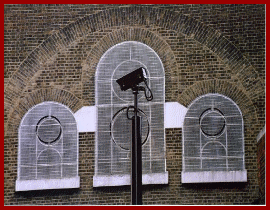| ||||||||||||||||||||||||||||
Welcome to the | ||||||||||||||||||||||||||||
 | ||||||||||||||||||||||||||||
 | ||||||||||||||||||||||||||||
CCTV CameraPerformance - Exposure Control
In practice, there are essentially three options for controlling the amount of light reaching the imager (CCD), but to better understand the workings of a modern CCTV camera, it's actually worth looking back thirty years to the days when camera imagers were large glass (thermionic) valves known as 'tubes'. The standard camera tube for most work was called a Vidicon, and this device could cope with quite enormous changes in scene illumination; in fact, a bright summers day at around 100,000 lux, could be reproduced almost as clearly as well after sunset (< 20 lux). This function of coping with changes in illumination is described as a devices 'Dynamic Range'. Because of the Vidicons wide dynamic range, it could quite happily use low cost, high performance manual iris lenses. Conversely, the high sensitivity cameras with their narrow dynamic range, needed to be fitted with far more expensive (and frequently inferior optical quality) auto iris lenses, but more about these later! When the original MOS (Metal Oxide Semiconductor) later CMOS (Complimentary Metal Oxide Semiconductor), and CCD (Charge Coupled Device) cameras arrived on the market, these also had a very narrow dynamic range, and so auto iris lenses were almost always fitted as standard. With the modern CCD camera, things couldn't be more different; excellent sensitivity, the selected introduction of 'Wide Dynamic' technology, and most being able to switch to an enhanced wide dynamic range, simply by enabling a function known as 'Electronic Iris' (EI) or 'Electronic Shutter'. | ||||||||||||||||||||||||||||
 | ||||||||||||||||||||||||||||
IMPORTANT: No material may be reproduced, copied or redistributed from this site, © doktorjon.co.uk 2004 - 2008 Homepage...:...Gateway...:...Technical Gateway....:....Quickfind Index....:....Equipment Directory | ||||||||||||||||||||||||||||

